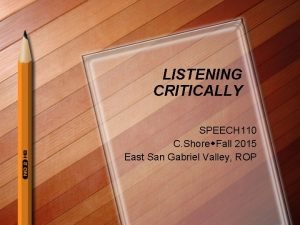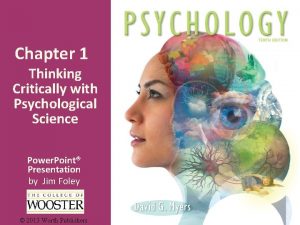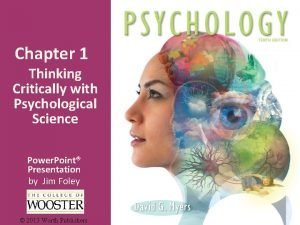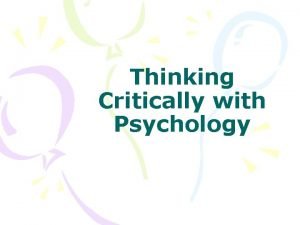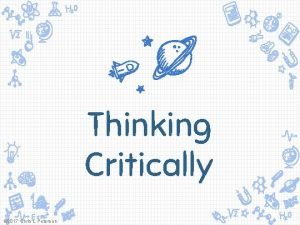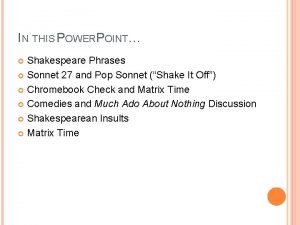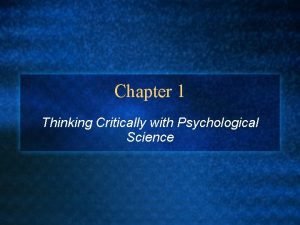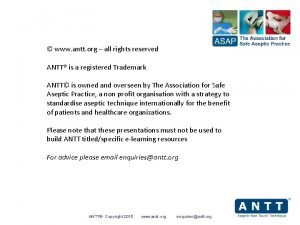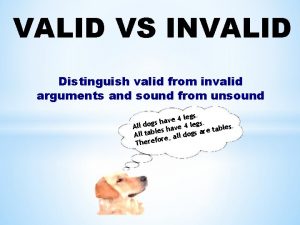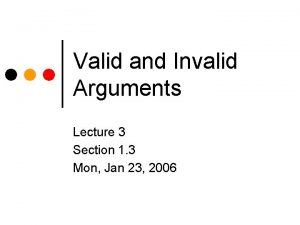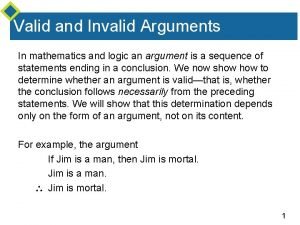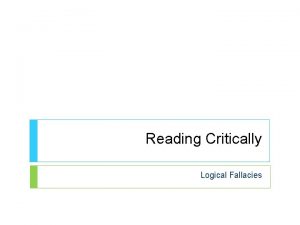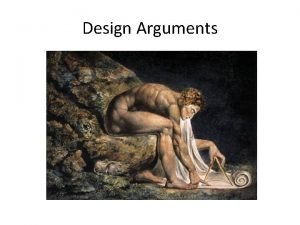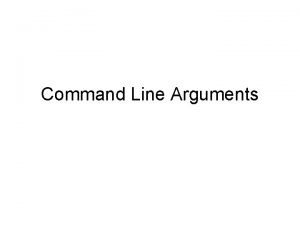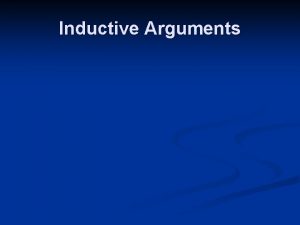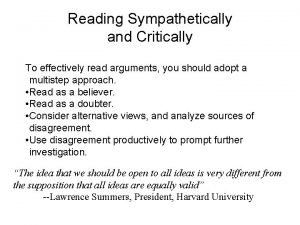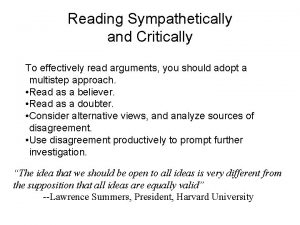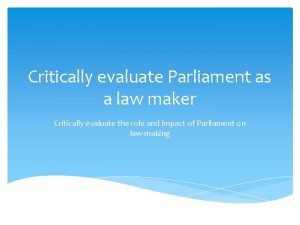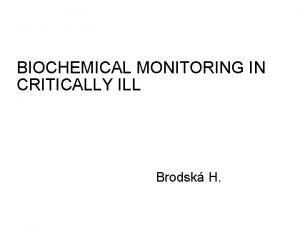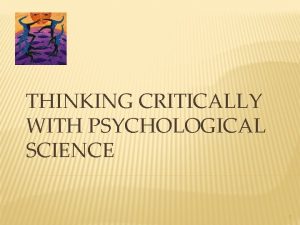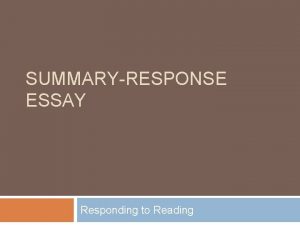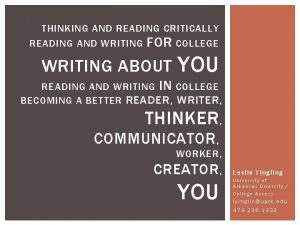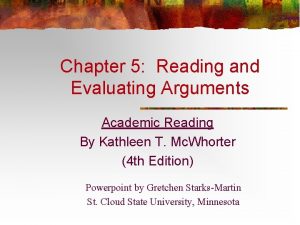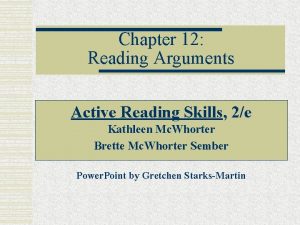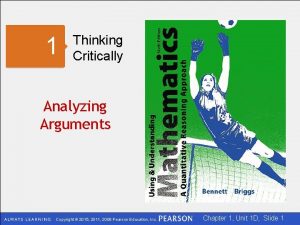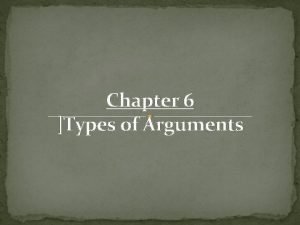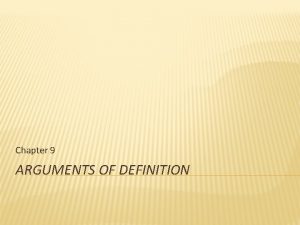Chapter 9 Reading Arguments Critically Arguments What is





























- Slides: 29

Chapter 9 Reading Arguments Critically

Arguments What is an argument? A writing that attempts to open readers’ minds to an opinion, change readers’ opinion, or move readers to action.

Arguments What is a good argument? �A work of negotiation and problem solving. �Both reader and writer search for knowledge to create common ground between them. Readers job: know whether you’re convinced by the argument

Elements of Argument 3 Main Elements �Claims: positive statements that require support (thesis statement) �Evidence: facts, examples, expert opinions, and other information that support the claim �Assumptions: writer’s underlying beliefs, opinions, etc that tie the evidence to the claim

Questions for Critically Reading an Argument �What claim does the writer make? �What kinds of quality evidence does the writer provide to support the claims. �What assumptions underlie the argument, connecting evidence to claims? Are they believable? �Is the writer reasonable? �Is the argument logical? �Are you convinced? Why or why not?

Recognizing Opinions Opinion – �a judgment based on facts and arguable on the basis of facts �Do not make arguments by themselves �You must satisfy yourself that the writer has specified evidence for the opinions. Example: The new room fees are unjustified given the condition of the dormitories.

Recognizing Facts Fact – �A verifiable statement that can be proved as true Example: Last year tuition increased 16 percent. �Claim of fact cannot work as thesis of an argument. �Facts offer crucial evidence for the claim

Recognizing Beliefs Belief – �A conviction based on cultural or personal faith, morality, or values �Often called opinions but they are not based on facts Example: Abortion is legalized murder. �Cannot serve as central or supporting claims of an argument.

Recognizing Prejudices Prejudice – �Opinion based on insufficient or unexamined evidence Example: Women are bad drivers. Athletes are unintelligent. �Prejudice is testable – can be contested and disproved on the basis of facts.

Evidence for Argument �Facts – verifiable statements �Statistics – facts expressed in numbers �Examples – specific cases �Expert opinions – judgments of authorities �Appeals to readers’ beliefs or needs

Criteria for Weighing Evidence �Is it accurate: trustworthy, exact, undistorted? �Is it relevant: authoritative, pertinent, current? �Is it representative: true to context? �Is it adequate: plentiful, specific?

Watching Language, Hearing Tone – �The expression of the writer’s attitudes toward himself or herself, toward the subject, toward the reader. �Can tell you quite a bit about the writer’s intentions, biases, and trustworthiness.

Reasonableness �The sense you get as a reader that the author is fair and sincere. �Writer does not conceal or hide facts, distort information, use language to manipulate you

Chapter 10 Writing an Argument

Argument �Try to clarify an issue or solve a problem �An argument subject must be arguable Reasonable people will disagree over it and be able to support their positions with evidence

Thesis Statement �Makes a claim that you want your readers to act on. Example: The new room fees are unjustified given the condition of the dormitories. �Must specify the basis of your claim

Analyzing Purpose and Audience Purpose – �engage your readers and convince them of your position or persuade them to act �Depends on the response of your readers (audience) Need a sense of who they are and where they stand

Using Reason The thesis of your argument is a conclusion you reach by reasoning about evidence. 2 types of reasoning: 1. Inductive 2. make specific observations and you induce or infer a generalization (or claim) Example: Model X is the most reliable. Deductive Proceed from generalization to your own specific circumstances See pgs. 200 &201

Using Reason

Using Evidence �Argument’s reasonableness depends on your evidence �Kind and quantity of evidence you use should be determined on your purpose, your subject and the needs of your audience.

Responsible Use of Evidence �Don’t distort �Don’t stack the deck �Don’t exaggerate �Don’t oversimplify �Don’t manipulate

Reaching Your Readers �Appeal to their reason and emotions �Present yourself as someone worth reading �You account for views opposing your own

Rational and Emotional Appeals �Most arguments combine both �Rational appeals Appeals to readers’ capacities for reasoning logically b/t evidence and claims �Emotional appeals Appeals to readers’ beliefs and feelings

Ethical Appeal �Sense you are being a competent, fair, trustworthy person �Ample evidence �Appropriate emotional appeals demonstrate you share readers’ beliefs and needs �Correct in grammar, spelling, etc – underscores confidence �Sincere tone – assure readers you are a balanced person who wants to reason with them

Ethical Appeal - AVOID �Insulting words �Biased language �Sarcasm �Exclamation points

Responding to Opposing Views �Good test of reasonableness is how you handle possible objections �You show yourself as honorable and fair �Strengthen your ethical appeal thus your entire argument �Common way to handle them – state them, then refute the ones you can. �Demonstrate why they are less compelling

Organizing your Argument �Introduction – establishes significance of the subject �Body – state and develop the claims supporting thesis using relevant evidence �Response to opposing views – addresses views, finds common ground, demonstrate greater strengths, etc. �Conclusion – completes the argument, restates thesis, summarizes the supporting claims, makes final appeal to readers


 Pre reading while reading and post reading activities
Pre reading while reading and post reading activities Critically thoughful
Critically thoughful Listening critically
Listening critically Thinking critically with psychological science
Thinking critically with psychological science Critically appraised topic voorbeeld
Critically appraised topic voorbeeld Care of critically ill surgical patient
Care of critically ill surgical patient Nasogastrio
Nasogastrio Thinking critically with psychological science
Thinking critically with psychological science General aseptic fields
General aseptic fields Illusory correlations ______.
Illusory correlations ______. Thinking critically
Thinking critically Define critical thinking in nursing
Define critical thinking in nursing Sonnet 27 meaning
Sonnet 27 meaning Negative issue
Negative issue Thinking critically with psychological science answer key
Thinking critically with psychological science answer key Antt safeguards
Antt safeguards St. louis
St. louis What are the aims of teaching reading?
What are the aims of teaching reading? What is intensive reading
What is intensive reading Edb net section
Edb net section An active process of discovery
An active process of discovery What is extensive reading
What is extensive reading Intensive reading and extensive reading
Intensive reading and extensive reading Characteristics of intensive reading
Characteristics of intensive reading What is at the root of most arguments and many fights
What is at the root of most arguments and many fights Emotivism ethics
Emotivism ethics Sound vs unsound arguments
Sound vs unsound arguments Propositional logic
Propositional logic Modus tollens
Modus tollens An error in reasoning that results in an invalid argument
An error in reasoning that results in an invalid argument


